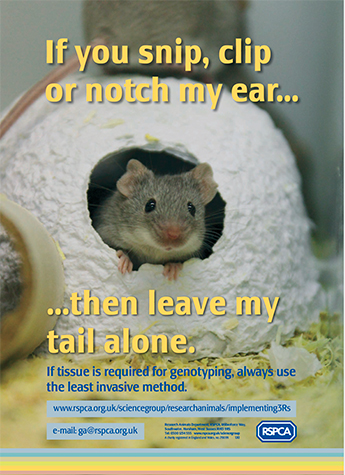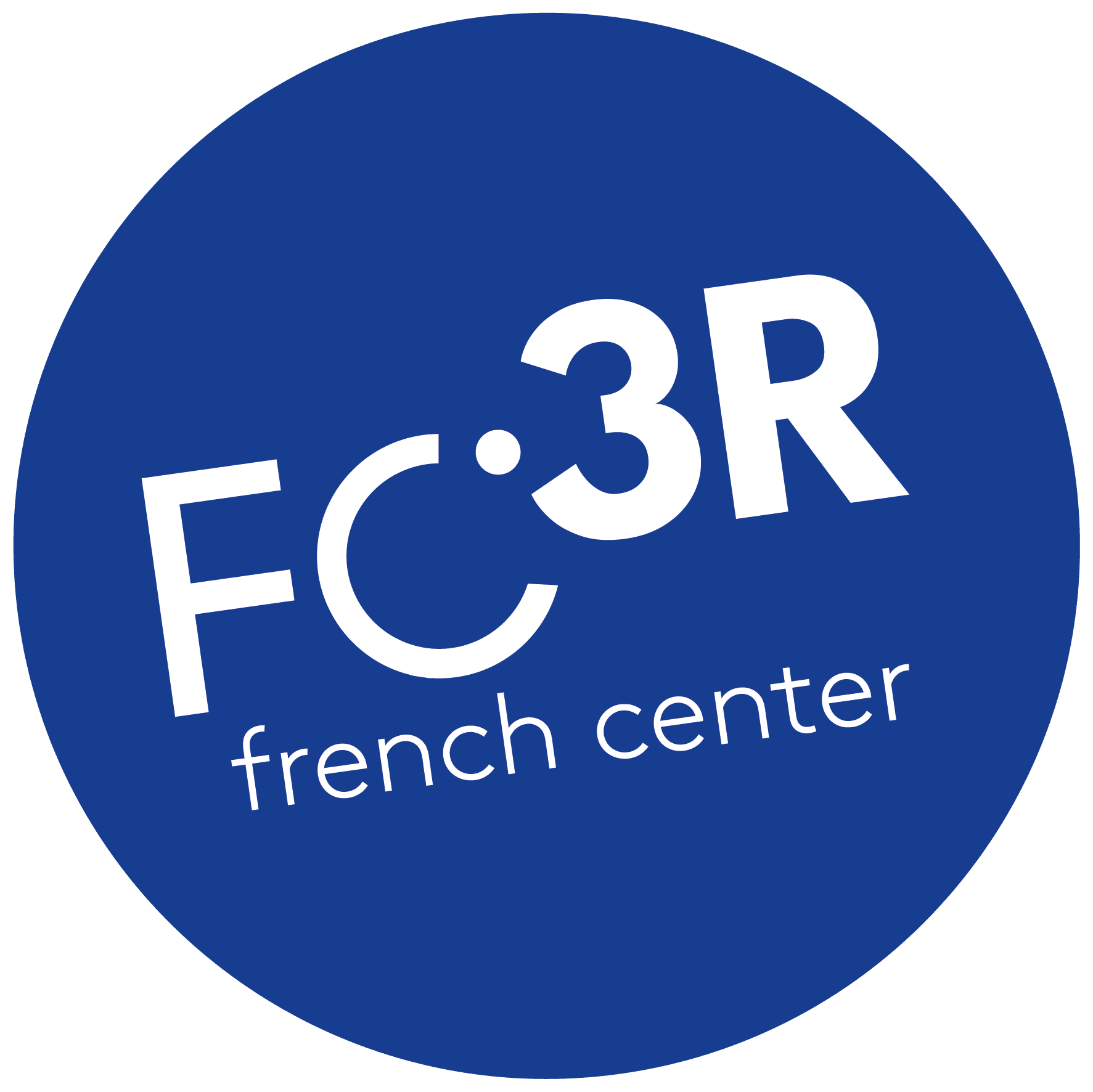
To learn more

View the replay of the FC3R webinar on non-invasive genotyping on January 16, 2025.
Additional resources, including guidelines and posters, are being added to the FRIA platform on a rolling basis: link to an example of a protocol for genotyping the Dicer murine line using hair samples).
If you have useful protocols that can be shared with the community, please share them by posting a Short Note or proposing a French-language data sheet in FRIA.
Genotyping, identification, and the regulatory framework
The breeding of genetically altered animals for scientific purposes (primarily mice, rats, and fish) requires reliable genotyping and identification techniques. Genotyping facilitates the routine tracking of genetic modifications and the monitoring of genetic status during colony maintenance. To facilitate this process, animals are identified individually, and a small piece of their tail is removed for genetic testing. In some cases, such as phalangectomy in mice, genotyping and identification are performed in a single operation. There are several techniques for genotyping laboratory animals that have been described in the literature (Bonaparte et al., 2013). These techniques can be classified as either invasive or non-invasive. Invasive techniques are classified as such if they are likely to cause pain, suffering, distress, or lasting harm equivalent to or greater than that caused by the prick of a needle. This classification follows good veterinary practice as defined by Directive 2010/63/EU.
Some of the invasive techniques, such as phalangectomy, which must be carried out between 7 and 10 days of age in rodents, require a Project Authorization (PA) as part of a specific scientific project (see CNREEA opinion). Other genotyping techniques involve the removal of a small part of a fish fin or a piece of a mouse tail at weaning age. These invasive practices are associated with painful physical alterations, including the potential for phantom pain. A growing body of clinical and preclinical evidence suggests that tissue damage can lead to long-term neurophysiological changes (Li, 2016). Non-invasive or less invasive genotyping alternatives are widely described in the scientific literature, albeit less widely used (Bonaparte et al., 2013). These include hair bulb sampling (Schmitteckert et al., 1999), droppings (Kalippke et al., 2009), saliva (Irwin et al., 1996), and fluorescence analysis (Hellrung et al., 2006). Some research projects require the identification of young rodents before they reach weaning age, and there are few non-invasive genotyping solutions available. While certain practices, such as buccal swabbing of newborn rodents (Zang et al., 2006), have been described, they have not been implemented (information provided by the authors themselves in preparation for this news item).
Legislation regarding rodent identification techniques is not subject to regulation (R 214-88 of the French Rural Code), and these techniques must be as painless as possible (Vademecum of the French Ministry of Agriculture and Food Sovereignty). Identification techniques that produce biological material for genotyping (such as ear biopsy with ringing at the same site) do not require PA.
Invasive genotyping techniques that cause pain, suffering or distress above the regulatory threshold (e.g. tail sampling in rodents or fin sampling in fish for genotyping) require a PA by Implementing Decision (EU) 2020/569. According to MESR figures, 326,033 genotyped but unused husbandry animals were recorded in France in 2022.
Pioneering initiatives in non-invasive genotyping
At the European level, the RSPCA initiated a campaign in 2010 to prevent the use of two techniques causing physical alterations from being used on the same animal. These techniques include identification by ear biopsy and removal of a tail tip for genotyping.
France’s UMR 1141 animal facility at the Robert Debré Hospital in Paris is among the first in the country to implement genotyping techniques without physical alteration, using hair bulbs. In 2020, the national Celphedia network conducted a multi-center comparative study on non-invasive genotyping techniques without physical alteration in mice and fish, generating positive technical results, especially for hair bulbs in mice (Jacquot et al., forthcoming). Despite the dissemination of these techniques through public channels such as congresses, webinars, and literature, their implementation remains suboptimal.
What is the most effective approach to implementing a genotyping technique that respects the 3Rs in an animal facility?
From Caen to Marseille, user establishments (EU) are marking the change. We have identified approximately ten animal facilities that have implemented non-invasive genotyping techniques in mice at weaning age, and we present three examples here:
“Yes, we Caen!”
In the 3R field, the University of Caen is distinguished by its dynamism. They have been implementing genotyping by hair bulb sampling for several years. In 2017, members of the laboratory conducted tests on their four murine lines, achieving positive results. Mélanie Coolzaet, Sophie Corvaisier, Stacy Largillière, and Gérald Née (COMETE technical team - UMRS1075), and Alexandre Lebrun (CURB) had quickly gained the support of the hierarchy and researchers, leading to the implementation and replacement of tail sampling. Rodents are weaned at approximately four to five weeks of age, and their hair bulbs are removed using a clamp at the same time.
What are the advantages?
Among the advantages, the team mentions the ease of the technique, the rapidity of results, and the improvement in animal welfare. From an administrative point of view, they don't need to include the sampling technique in a PA.
What are the disadvantages of this approach?
It is not necessary to use forceps with this process, provided that the forceps are thoroughly cleaned between each sampling.
Marseille, the crossroads of dynamism
In Marseille in 2022, following a presentation on regulations by a member of the AFiS team, Séverine Platel, animal facility manager at UMR 7288, realized that it would be important to change genotyping techniques. Tests on hair sampling had already been carried out in 2021 by molecular biology engineer Mélanie Hocine, which had enabled the technique to make good progress.
What are the advantages?
The team has identified several key advantages of this approach, including its simplicity, the ability to perform it concurrently with the fitting of identification rings, the rapidity of the results, and the enhancement of animal welfare. From an administrative perspective, there is no requirement to incorporate the technique within a AP.
What are the disadvantages of this approach?
While some researchers were initially hesitant, their superiors and the EU's scientific director endorsed the transition.
École Nationale Vétérinaire d'Alfort (EnvA)
At EnvA, within the U955 IMRB unit, Laurent Guillaud utilizes buccal swabbing to re-genotype rats. Concurrently, genotyping from droppings is yielding positive results in mice and specific rat lines, thanks to a promising protocol that will be shared in the near future.
What are the advantages?
Swabbing in rats is a simple, rapid technique that can easily be performed at any time. Mouse feces are easily collected during the three- to four-week identification stage. As soon as the mouse is restrained, defecation occurs almost instantaneously.
What are the disadvantages of this approach?
Collecting feces from rats often requires a thorough massage of the colon, which can be very time-consuming, if not impossible. In addition, massage is not feasible for adult mice due to their increased size.
A beneficial and dynamic evolution
Over the last ten years, the implementation of non-invasive genotyping has shown that its adoption is accelerating, particularly due to the requirement to submit a Project Authorization Application since 2020. This change is primarily occurring in areas that have already been identified as having highly dynamic professionals, such as animal facility managers, committed teachers/researchers, and EU scientific managers.
The advantages of this approach are clear: simplified methods, accelerated outcomes, enhanced animal welfare, and reduced bureaucracy. Furthermore, we acknowledge that the implementation of these non-invasive methods has led to favorable feedback from teams and even recognition for some colleagues during professional appraisals.
